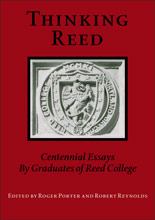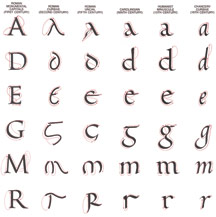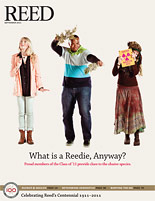
IRIS login | Reed College home Volume 90, No. 3: September 2011
Thinking Reed: Centennial Essays
Rescued from a Life of Crime
By Chuck Bigelow ’67

This essay was adapted from Thinking Reed: Centennial Essays By Reed Graduates, edited by Professors Roger Porter and Robert Reynolds, in which 33 alumni reflect on their careers as they look back at Reed and the intellectual community that helped shape their accomplishments.
Reed College saved me from a life of crime. The thing is, I never would have gone to Reed if I hadn’t gotten into too much trouble in high school. Rebellious and bored, I pursued studies outside the curriculum, such as distilling a gallon of apple brandy—which got my friends roaring drunk—and blowing up a bit of the old school with homemade pyrotechnic—which lit up midnight like a lightning flash and woke the neighborhood for a mile around.
I went from honor roll to probation amid dire predictions of my dark future. My high school swore to inform the FBI of my misdeeds if ever I applied for honorable government service, say the CIA, and promised to put in a bad word if I applied to Ivy League colleges, so I applied to Reed by a principle of antisymmetry. Repulsed by my high school’s rigid, conservative authoritarianism, I wanted a college that was relaxed, liberal, and egalitarian. Smothered by my school’s hypocrisy and petty-mindedness, I wanted a college that promoted serious debate and broad inquiry.
I doubt that my high school bothered to warn Reed of my misdeeds, but if it did, Reed didn’t care, because one fine fall day I sat on a hard wooden bench in the Reed chapel listening to the first freshman humanities lecture. Charles Svitavsky intoned the first lines of the Odyssey: “Andra moi ennepe, Mousa, polytropon . . .” “Tell me, Muse, of the many-turned man . . .” What could be cooler than this, I thought, words a poet spoke 3,000 years ago still echoing in English from Greek borrowings and coinages like android, polymer, tropism, and muse. If Odysseus was polytropon—“many-turned”—did that mean “much-traveled” or “very tricky”? How did the epithets work, I wondered?

Evolution of an alphabet. Red lines trace the ductus, or path of the writing tool; broken lines indicate the part of the ductus that is invisible because the tool is not in contact with the writing surface. The Latin alphabet has largely evolved from the interplay of the opposing tendencies between formal alphabets such as the Roman capitals, in which most of the ductus is invisible, and cursive alphabets, such as Chancery cursive, in which most of the ductus is visible. Calligraphy by Kris Holmes ’72, from Scientific American, August, 1983.
Reed demonstrated how modern forms come from ancient motifs, themselves much-traveled and many-turned. In Humanities 110 conference, when we talked about Odysseus’ wife, Penelope, weaving the shroud by day but unraveling it by night to avoid remarriage, a colorful Texan in the class opined, “Here’s Penelope waiting faithfully for her man, while ol’ Odysseus is out there shacking up with every broad he meets. It’s the old double standard.” We laughed, even Professor Richard Jones. Like so much else I learned at Reed, it was smart, funny, and spontaneous, but also sincere, and it came from a combination of student and professor.
A few years ago, the movie Transformers thrilled teen audiences with giant, marauding robots and a sexy nymph, played by an actress aptly named Fox, who enthralls a scrambling young hero for two hours. It reminded me that for 3,000 years, the Odyssey has thrilled audiences and readers with man-eating Cyclops and a sexy nymph aptly named Calypso (“she who conceals”) who enthralls a wandering hero, Odysseus, as her love slave for seven years. As my Reed classmate might have said, “Hey, it’s the same ol’ story!”
When you learned something new at Reed, it wasn’t simply a fact, but a tool and an opportunity to discover more patterns and parallels. Because of this, I wasn’t bored at Reed, unlike in high school, so my delinquent tendencies were rechanneled. I didn’t lose my taste for pranks, but I learned to enjoy the intellectual jest. For a course taught by James Webb, I rewrote Euripedes’ lurid tragedy, the Bacchae, as a news story from the National Enquirer: “Queen rips son to shreds with bare hands! Crazed by mind drug made from grapes, carries home head as souvenir! Freaky feminine sex cult feared!” Okay, it was the sixties.
Without explicit grades, honor rolls, or other status substitutes for real knowledge, Reed students delighted in devising unexpected ways to discover new things and to cast known things in new light. The physicist Richard Feynman has said the “pleasure of finding the thing out” was the theme of his intellectual life, and for me that was half of what Reed was about. The other half was the fun of sharing what you found out.
Many of the more interesting—or at least more entertaining—things were done outside of class, to amuse, puzzle, or astonish other students. When an offhand conversation in the library suggested that men’s and women’s graffiti were different, I collaborated with a female anthropology student to conduct cross-gender graffiti tours of the men’s and women’s rooms in the library. (The graffiti were different.)
“Grape jokes” were a group of riddle-puns that conflated unlike entities, one of which was always a grape or something related to grapes (wine, raisins, etc.). When they were briefly popular at Reed, I devised a kind of symbolic logic to analyze their humor as semantic distance between the entities contrasted with their phonological similarity. (Q: What’s purple and conquered the world? A: Alexander the Grape.) I circulated an informal paper about this among my classmates in linguistics (in a course taught by David French ’39), but they complained that my analysis of humor wasn’t funny. I wondered why there was a gulf between the analytic and the sensible.
Turns out, the problem had been posed 24 centuries earlier by Democritus of Abdera, an early atomist known also for his sense of humor. In his dialogue between the intellect and the senses, the intellect says, “Ostensibly there is color, ostensibly sweetness, ostensibly bitterness; actually, only atoms and the void.” The senses reply, “Poor Intellect, how can you defeat us when from us you borrow your evidence?” (I found this fragment quoted in an essay by Erwin Schrödinger, the quantum theorist also known for his theory of color.) To follow a train of thought not taught in class, but perhaps for which class has prepared you, and unexpectedly to find yourself in the company of A-list thinkers like Democritus and Schrödinger that for me was almost as much fun as brewing bathtub brandy or blowing up part of the school, and a whole lot safer.
For me, Reed’s influence was more a matter of style than content. Not specific skills or facts, but rather a manner of thinking, an attitude toward learning, a taste for the recondite, a delight in a joke that illuminated a problem, a conviction that to learn the most interesting things, you had to teach yourself.
With one exception, the courses I took at Reed did not become the foundation of my career, though the ways professors approached their subjects often permeated how I later thought about things. It took me years to appreciate the truth of trenchant comments by Gail Kelly [’55], and the same for wry remarks by Howard Jolly. The exceptional course was calligraphy, which I took in my senior year as a diversion unrelated to my major, anthropology.


LATEST COMMENTS
steve-jobs-1976 I knew Steve Jobs when he was on the second floor of Quincy. (Fall...
Utnapishtim - 2 weeks ago
Prof. Mason Drukman [political science 1964–70] This is gold, pure gold. God bless, Prof. Drukman.
puredog - 1 month ago
virginia-davis-1965 Such a good friend & compatriot in the day of Satyricon...
czarchasm - 4 months ago
John Peara Baba 1990 John died of a broken heart from losing his mom and then his...
kodachrome - 7 months ago
Carol Sawyer 1962 Who wrote this obit? I'm writing something about Carol Sawyer...
MsLaurie Pepper - 8 months ago
William W. Wissman MAT 1969 ...and THREE sisters. Sabra, the oldest, Mary, the middle, and...
riclf - 10 months ago